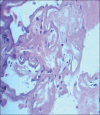Treatment and outcome of epileptogenic temporal cavernous malformations
- PMID: 25836611
- PMCID: PMC4834007
- DOI: 10.4103/0366-6999.154289
Treatment and outcome of epileptogenic temporal cavernous malformations
Abstract
Background: The aim of this study is to explore the treatment and outcome of epileptogenic temporal lobe cavernous malformations (CMs).
Methods: We analyzed retrospectively the profiles of 52 patients diagnosed as temporal lobe CMs associated with epilepsy. Among the 52 cases, 11 underwent a direct resection of CM along with the adjacent zone of hemosiderin rim without electrocorticogram (ECoG) monitoring while the other 41 cases had operations under the guidance of ECoG. Forty-six patients were treated by lesionectomy + hemosiderin rim while the other six were treated by lesionectomy + hemosiderin rim along with extended epileptogenic zone resection. The locations of lesions, the duration of illness, the manifestation, the excision ranges and the outcomes of postoperative follow-up were analyzed, respectively.
Results: All of the 52 patients were treated by microsurgery. There was no neurological deficit through the long-term follow-up. Outcomes of seizure control are as follows: 42 patients (80.8%) belong to Engel Class I, 5 patients (9.6%) belong to Engel Class II, 3 patients (5.8%) belong to Engel Class III and 2 patients (3.8%) belong to Engel Class IV.
Conclusion: Patients with epilepsy caused by temporal CMs should be treated as early as possible. Resection of the lesion and the surrounding hemosiderin zone is necessary. Moreover, an extended excision of epileptogenic cortex or cerebral lobes is needed to achieve a better prognosis if the ECoG indicates the existence of an extra epilepsy onset origin outside the lesion itself.
Conflict of interest statement
Figures





Similar articles
-
Seizure outcome after surgical resection of supratentorial cavernous malformations plus hemosiderin rim in patients with short duration of epilepsy.Clin Neurol Neurosurg. 2014 Apr;119:59-63. doi: 10.1016/j.clineuro.2014.01.013. Epub 2014 Jan 25. Clin Neurol Neurosurg. 2014. PMID: 24635927
-
Surgical Treatment and Long-Term Outcome of Cerebral Cavernous Malformations-Related Epilepsy in Pediatric Patients.Neuropediatrics. 2018 Jun;49(3):173-179. doi: 10.1055/s-0038-1645871. Epub 2018 Apr 20. Neuropediatrics. 2018. PMID: 29677701
-
Is additional mesial temporal resection necessary for intractable epilepsy with cavernous malformations in the temporal neocortex?Epilepsy Behav. 2019 Mar;92:145-153. doi: 10.1016/j.yebeh.2018.12.024. Epub 2019 Jan 16. Epilepsy Behav. 2019. PMID: 30660057
-
Microsurgical treatment of temporal lobe cavernomas.Acta Neurochir (Wien). 2011 Feb;153(2):261-70. doi: 10.1007/s00701-010-0812-5. Epub 2010 Sep 26. Acta Neurochir (Wien). 2011. PMID: 20872256 Review.
-
The Role of Hemosiderin Excision in Seizure Outcome in Cerebral Cavernous Malformation Surgery: A Systematic Review and Meta-Analysis.PLoS One. 2015 Aug 25;10(8):e0136619. doi: 10.1371/journal.pone.0136619. eCollection 2015. PLoS One. 2015. PMID: 26305879 Free PMC article.
Cited by
-
Predictors of postoperative epileptic seizures after microsurgical treatment in supratentorial single cerebral cavernous malformations: a retrospective study.Langenbecks Arch Surg. 2025 May 20;410(1):164. doi: 10.1007/s00423-025-03741-5. Langenbecks Arch Surg. 2025. PMID: 40392358 Free PMC article.
-
Should we resect peri-lesional hemosiderin deposits when performing lesionectomy in patients with cavernoma-related epilepsy (CRE)?Neurosurg Rev. 2017 Jan;40(1):39-43. doi: 10.1007/s10143-016-0797-5. Epub 2016 Nov 8. Neurosurg Rev. 2017. PMID: 27822594 Review.
-
Treatment of Cerebral Cavernous Malformations Presenting With Seizures: A Systematic Review and Meta-Analysis.Front Neurol. 2020 Oct 26;11:590589. doi: 10.3389/fneur.2020.590589. eCollection 2020. Front Neurol. 2020. PMID: 33193057 Free PMC article.
References
-
- Batra S, Lin D, Recinos PF, Zhang J, Rigamonti D. Cavernous malformations: Natural history, diagnosis and treatment. Nat Rev Neurol. 2009;5:659–70. - PubMed
-
- Bertalanffy H, Benes L, Miyazawa T, Alberti O, Siegel AM, Sure U. Cerebral cavernomas in the adult. Review of the literature and analysis of 72 surgically treated patients. Neurosurg Rev. 2002;25:1–53. - PubMed
-
- Awad I, Jabbour P. Cerebral cavernous malformations and epilepsy. Neurosurg Focus. 2006;21:e7. - PubMed
-
- Ferrier CH, Aronica E, Leijten FS, Spliet WG, Boer K, van Rijen PC, et al. Electrocorticography discharge patterns in patients with a cavernous hemangioma and pharmacoresistent epilepsy. J Neurosurg. 2007;107:495–503. - PubMed
MeSH terms
LinkOut - more resources
Full Text Sources
Other Literature Sources
Medical

